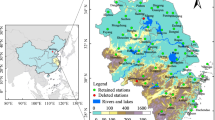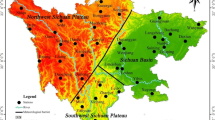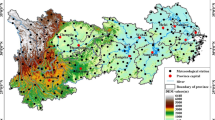Abstract
With the intensification of global warming, extreme precipitation events occur frequently all over the world. Extreme precipitation has brought huge challenges to the development of human society and economy, and it is urgent to strengthen the analysis of the causes of extreme precipitation. In this study, we first extracted precipitation events from the precipitation time series from 1960 to 2018 in the Huaihe River Basin (HRB) and then extracted extreme precipitation events based on precipitation amount and precipitation intensity. The results show that extreme precipitation in the HRB has an increasing trend after 2000, although the increasing trend is not obvious, and the uncertainty of the occurrence of extreme precipitation events had increased. Extreme precipitation mainly had a strong correlation with the surface air temperature in the North Pacific, Indian Ocean, and Qinghai–Tibet Plateau. The El Niño year and the year of abnormal circulation contribute to the production of extreme precipitation in the HRB. In the years when extremely heavy precipitation occurred in the HRB, the subtropical high was northerly. Although most of the water vapor is brought from the Pacific by the East Asian monsoon, the water vapor that causes extreme precipitation in the HRB mainly comes from the Indian Ocean. Through multivariate wavelet coherence (MWC) analysis, annual precipitation is greatly affected by multiple climate variables, while extreme precipitation is greatly affected by a single climate variable. This study provides an important reference for the analysis and prediction of extreme precipitation.























Similar content being viewed by others
Data availability
The climate indices data were used for this study and downloaded from https://www.cpc.ncep.noaa.gov that was freely available for users.
Code availability
Not applicable.
References
Aihaiti A, Jiang Z, Zhu L, Li W, You Q (2021) Risk changes of compound temperature and precipitation extremes in China under 1.5 °C and 2 °C global warming. Atmos Res 264:105838. https://doi.org/10.1016/j.atmosres.2021.105838
Breugem AJ, Wesseling JG, Oostindie K, Ritsema CJ (2020) Meteorological aspects of heavy precipitation in relation to floods – an overview. Earth-Science Rev 204:103171. https://doi.org/10.1016/j.earscirev.2020.103171
Cai S, Hsu P-C, Liu F (2021) Changes in polar amplification in response to increasing warming in CMIP6. Atmos Ocean Sci Lett 14:100043. https://doi.org/10.1016/j.aosl.2021.100043
Cao Q, Jiang B, Shen X, Lin W, Chen J (2021) Microphysics effects of anthropogenic aerosols on urban heavy precipitation over the Pearl River Delta. China Atmos Res 253:105478. https://doi.org/10.1016/j.atmosres.2021.105478
Carvalho D, Rocha A, Costoya X, deCastro M, Gómez-Gesteira M (2021) Wind energy resource over Europe under CMIP6 future climate projections: what changes from CMIP5 to CMIP6. Renew Sustain Energy Rev 151:111594. https://doi.org/10.1016/j.rser.2021.111594
Chen F, Yuan H, Sun R, Yang C (2020) Streamflow simulations using error correction ensembles of satellite rainfall products over the Huaihe river basin. J Hydrol 589:125179. https://doi.org/10.1016/j.jhydrol.2020.125179
Cheng H, Wang W, van Oel PR, Lu J, Wang G, Wang H (2021) Impacts of different human activities on hydrological drought in the Huaihe River Basin based on scenario comparison. J Hydrol Reg Stud 37:100909. https://doi.org/10.1016/j.ejrh.2021.100909
Chong KL, Huang YF, Koo CH, Najah Ahmed A, El-Shafie A (2022) Spatiotemporal variability analysis of standardized precipitation indexed droughts using wavelet transform. J Hydrol 605:127299. https://doi.org/10.1016/j.jhydrol.2021.127299
Dar J, Nabi S, Dar AQ, Ahanger MA (2021) The anatomy of extreme precipitation events over Srinagar, Kashmir, India, over the past 50 years. Arab J Geosci 14:1412. https://doi.org/10.1007/s12517-021-07820-x
Douluri DL, Chakraborty A (2021) Assessment of WRF-ARW model parameterization schemes for extreme heavy precipitation events associated with atmospheric rivers over West Coast of India. Atmos Res 249:105330. https://doi.org/10.1016/j.atmosres.2020.105330
Ergin E, Altinel B, Aktas E (2021) A mixed method study on global warming, climate change and the role of public health nurses from the perspective of nursing students. Nurse Educ Today 107:105144. https://doi.org/10.1016/j.nedt.2021.105144
Gao M, Kim S-J, Yang J, Liu J, Jiang T, Su B, Wang Y, Huang J (2021) Historical fidelity and future change of Amundsen Sea Low under 15 °C–4 °C global warming in CMIP6. Atmos Res 255:105533. https://doi.org/10.1016/j.atmosres.2021.105533
Güçlü YS (2020) Improved visualization for trend analysis by comparing with classical Mann-Kendall test and ITA. J Hydrol 584:124674. https://doi.org/10.1016/j.jhydrol.2020.124674
Hu W, Si BC (2016) Technical note: multiple wavelet coherence for untangling scale-specific and localized multivariate relationships in geosciences. Hydrol Earth Syst Sci 20:3183–3191. https://doi.org/10.5194/hess-20-3183-2016
Hu X-M, Ma J-R, Ying J, Cai M, Kong Y-Q (2021) Inferring future warming in the Arctic from the observed global warming trend and CMIP6 simulations. Adv Clim Chang Res. https://doi.org/10.1016/j.accre.2021.04.002
Huang H, Cui H, Ge Q, (2021) Will a nonstationary change in extreme precipitation affect dam security in China? J Hydrol 126859https://doi.org/10.1016/j.jhydrol.2021.126859
Lei X, Gao L, Ma M, Wei J, Xu L, Wang L, Lin H (2021) Does non-stationarity of extreme precipitation exist in the Poyang Lake Basin of China? J Hydrol Reg Stud 37:100920. https://doi.org/10.1016/j.ejrh.2021.100920
Li R, Huang Y, Xie F, Fu Z (2021a) Discrepancies in surface temperature between NCEP reanalysis data and station observations over China and their implications: 中国地区NCEP再分析资料与台站观测的地表温度差异及其影响. Atmos Ocean Sci Lett 14:100008. https://doi.org/10.1016/j.aosl.2020.100008
Li X, Zhang K, Gu P, Feng H, Yin Y, Chen W, Cheng B (2021b) Changes in precipitation extremes in the Yangtze River Basin during 1960–2019 and the association with global warming, ENSO, and local effects. Sci Total Environ 760:144244. https://doi.org/10.1016/j.scitotenv.2020.144244
Li Y, Wang W, Chang M, Wang X (2021c) Impacts of urbanization on extreme precipitation in the Guangdong-Hong Kong-Macau Greater Bay Area. Urban Clim 38:100904. https://doi.org/10.1016/j.uclim.2021.100904
Liu H, Liu X, Dong B (2017) Intraseasonal variability of winter precipitation over central Asia and the western Tibetan Plateau from 1979 to 2013 and its relationship with the North Atlantic Oscillation. Dyn Atmos Ocean 79:31–42. https://doi.org/10.1016/j.dynatmoce.2017.07.001
Liu S, Yin Y, Xiao H, Jiang H, Shi R (2021a) The effects of ice nucleation on the microphysical processes and precipitation for a heavy rainfall event in Beijing. Atmos Res 253:105476. https://doi.org/10.1016/j.atmosres.2021.105476
Liu X, Yuan X, Zhu E (2021b) Global warming induces significant changes in the fraction of stored precipitation in the surface soil. Glob Planet Change 205:103616. https://doi.org/10.1016/j.gloplacha.2021.103616
Lu T, Cui X, Zou Q, Li H (2021) Atmospheric water budget associated with a local heavy precipitation event near the Central Urban Area of Beijing Metropolitan Region. Atmos Res 260:105600. https://doi.org/10.1016/j.atmosres.2021.105600
Luo Y, Wu M, Ren F, Li J, Wong W-K (2016) Synoptic situations of extreme hourly precipitation over China. J Clim 29:8703–8719. https://doi.org/10.1175/JCLI-D-16-0057.1
MacDonald MK, Pomeroy JW, Essery RLH (2018) Water and energy fluxes over northern prairies as affected by chinook winds and winter precipitation. Agric for Meteorol 248:372–385. https://doi.org/10.1016/j.agrformet.2017.10.025
Mandal S, Islam MS, Biswas MHA, Akter S (2022) A mathematical model applied to investigate the potential impact of global warming on marine ecosystems. Appl Math Model 101:19–37. https://doi.org/10.1016/j.apm.2021.08.026
Michel C, Sorteberg A, Eckhardt S, Weijenborg C, Stohl A, Cassiani M (2021) Characterization of the atmospheric environment during extreme precipitation events associated with atmospheric rivers in Norway - seasonal and regional aspects. Weather Clim Extrem 34:100370. https://doi.org/10.1016/j.wace.2021.100370
Mo Y, Li Q, Karimian H, Zhang S, Kong X, Fang S, Tang B (2021) Daily spatiotemporal prediction of surface ozone at the national level in China: an improvement of CAMS ozone product. Atmos Pollut Res 12:391–402. https://doi.org/10.1016/j.apr.2020.09.020
Mondal SK, Tao H, Huang J, Wang Y, Su B, Zhai J, Jing C, Wen S, Jiang S, Chen Z, Jiang T (2021) Projected changes in temperature, precipitation and potential evapotranspiration across Indus River Basin at 1.5–3.0 °C warming levels using CMIP6-GCMs. Sci Total Environ 789:147867. https://doi.org/10.1016/j.scitotenv.2021.147867
Mou S, Shi P, Qu S, Feng Y, Chen C, Dong F (2020) Projected regional responses of precipitation extremes and their joint probabilistic behaviors to climate change in the upper and middle reaches of Huaihe River Basin. China Atmos Res 240:104942. https://doi.org/10.1016/j.atmosres.2020.104942
Muñoz E, Poveda G, Patricia Arbeláez M, Vélez ID, (2021) Spatiotemporal dynamics of dengue in Colombia in relation to the combined effects of local climate and ENSO. Acta Trop 106136https://doi.org/10.1016/j.actatropica.2021.106136
Nguyen L, Rohrer M, Schwarb M, Stoffel M (2020) Development of a combined empirical index for a 5-day forecast of heavy precipitation over the Bernese Alps. Environ Int 135:105357. https://doi.org/10.1016/j.envint.2019.105357
Nyikadzino B, Chitakira M, Muchuru S (2020) Rainfall and runoff trend analysis in the Limpopo river basin using the Mann Kendall statistic. Phys Chem Earth Parts A/B/C 117:102870. https://doi.org/10.1016/j.pce.2020.102870
Ogorodnikov VA, Sereseva OV (2015) Multiplicative numerical stochastic model of daily sums of liquid precipitation fields and its use for estimating statistical characteristics of extreme precipitation regimes. Atmos Ocean Opt 28:328–335. https://doi.org/10.1134/S1024856015040107
Patra A, Min S-K, Kumar P, Wang XL (2021) Changes in extreme ocean wave heights under 15 °C, 2 °C, and 3 °C global warming. Weather Clim Extrem 33:100358. https://doi.org/10.1016/j.wace.2021.100358
Räisänen J (2021) Effect of atmospheric circulation on surface air temperature trends in years 1979–2018. Clim Dyn 56:2303–2320. https://doi.org/10.1007/s00382-020-05590-y
Ren X, Sha Y, Shi Z, Liu X (2021) Response of summer extreme precipitation over East Asia during the mid-Holocene versus future global warming. Glob Planet Change 197:103398. https://doi.org/10.1016/j.gloplacha.2020.103398
Sadeghi S, Tootle G, Elliott E, Lakshmi V, Therrell M, Kam J, Bearden B (2019) Atlantic ocean sea surface temperatures and southeast united states streamflow variability: associations with the recent multi-decadal decline. J Hydrol 576:422–429. https://doi.org/10.1016/j.jhydrol.2019.06.051
Sadeghi M, Shearer EJ, Mosaffa H, Gorooh VA, Rahnamay Naeini M, Hayatbini N, Katiraie-Boroujerdy P-S, Analui B, Nguyen P, Sorooshian S (2021) Application of remote sensing precipitation data and the CONNECT algorithm to investigate spatiotemporal variations of heavy precipitation: case study of major floods across Iran (Spring 2019). J Hydrol 600:126569. https://doi.org/10.1016/j.jhydrol.2021.126569
Schauwecker S, Schwarb M, Rohrer M, Stoffel M (2021) Heavy precipitation forecasts over Switzerland – an evaluation of bias-corrected ECMWF predictions. Weather Clim Extrem 34:100372. https://doi.org/10.1016/j.wace.2021.100372
Shi P, Preisler HK, Quinn BK, Zhao J, Huang W, Röll A, Cheng X, Li H, Hölscher D (2020) Precipitation is the most crucial factor determining the distribution of moso bamboo in Mainland China. Glob Ecol Conserv 22:e00924. https://doi.org/10.1016/j.gecco.2020.e00924
Sun W, Mu X, Song X, Wu D, Cheng A, Qiu B (2016) Changes in extreme temperature and precipitation events in the Loess Plateau (China) during 1960–2013 under global warming. Atmos Res 168:33–48. https://doi.org/10.1016/j.atmosres.2015.09.001
Vázquez M, Nieto R, Liberato MLR, Gimeno L (2020) Atmospheric moisture sources associated with extreme precipitation during the peak precipitation month. Weather Clim Extrem 30:100289. https://doi.org/10.1016/j.wace.2020.100289
Wang X, Jiang D, Lang X (2017) Future extreme climate changes linked to global warming intensity. Sci Bull 62:1673–1680. https://doi.org/10.1016/j.scib.2017.11.004
Wang H, Gao T, Xie L (2019) Correction to: Extreme precipitation events during 1960–2011 for the Northwest China: space-time changes and possible causes. Theor Appl Climatol 137:997–999. https://doi.org/10.1007/s00704-018-2668-1
Wang G, Zhang Q, Yu H, Shen Z, Sun P (2020) Double increase in precipitation extremes across China in a 1.5 °C/2.0 °C warmer climate. Sci Total Environ 746:140807. https://doi.org/10.1016/j.scitotenv.2020.140807
Wang J, Liu Y, Ding Y, Wu Z (2021a) Towards influence of Arabian Sea SST anomalies on the withdrawal date of Meiyu over the Yangtze-Huaihe River basin. Atmos Res 249:105340. https://doi.org/10.1016/j.atmosres.2020.105340
Wang P, Huang Q, Tang Q, Chen X, Yu J, Pozdniakov SP, Wang T, (2021b) Increasing annual and extreme precipitation in permafrost-dominated Siberia during 1959–2018. J Hydrol 126865https://doi.org/10.1016/j.jhydrol.2021.126865
Wei L, Gu X, Kong D, Liu J (2021) A long-term perspective of hydroclimatological impacts of tropical cyclones on regional heavy precipitation over eastern monsoon China. Atmos Res 264:105862. https://doi.org/10.1016/j.atmosres.2021.105862
Wu H, Li X, Qian H (2021) Temporal variability in extremes of daily precipitation, daily maximum and minimum temperature in Shaanxi. China J Atmos Solar-Terrestrial Phys 215:105585. https://doi.org/10.1016/j.jastp.2021.105585
Xu Z, Pan B, Han M, Zhu J, Tian L (2019) Spatial–temporal distribution of rainfall erosivity, erosivity density and correlation with El Niño-Southern Oscillation in the Huaihe River Basin. China Ecol Inform 52:14–25. https://doi.org/10.1016/j.ecoinf.2019.04.004
Xu L, Wang A, Yu W, Yang S (2021) Hot spots of extreme precipitation change under 1.5 and 2 °C global warming scenarios. Weather Clim Extrem 33:100357. https://doi.org/10.1016/j.wace.2021.100357
Xu Y, Sun H, Ji X (2021b) Spatial-temporal evolution and driving forces of rainfall erosivity in a climatic transitional zone: a case in Huaihe River Basin, eastern China. CATENA 198:104993. https://doi.org/10.1016/j.catena.2020.104993
Yao J, Chen Y, Chen J, Zhao Y, Tuoliewubieke D, Li J, Yang L, Mao W (2021) Intensification of extreme precipitation in arid Central Asia. J Hydrol 598:125760. https://doi.org/10.1016/j.jhydrol.2020.125760
Yin Y, Han C, Yang G, Huang Y, Liu M, Wang X (2020) Changes in the summer extreme precipitation in the Jianghuai plum rain area and their relationship with the intensity anomalies of the south Asian high. Atmos Res 236:104793. https://doi.org/10.1016/j.atmosres.2019.104793
Zambreski ZT, Lin X, Aiken RM, Kluitenberg GJ, Pielke RA Sr (2018) Identification of hydroclimate subregions for seasonal drought monitoring in the U.S. Great Plains J Hydrol 567:370–381. https://doi.org/10.1016/j.jhydrol.2018.10.013
Zhai P, Zhang X, Wan H, Pan X (2005) Trends in total precipitation and frequency of daily precipitation extremes over China. J Clim 18:1096–1108. https://doi.org/10.1175/JCLI-3318.1
Zhang W, Zhou T (2020) Increasing impacts from extreme precipitation on population over China with global warming. Sci Bull 65:243–252. https://doi.org/10.1016/j.scib.2019.12.002
Zhang Q, Zhang J, Yan D, Wang Y (2014) Extreme precipitation events identified using detrended fluctuation analysis (DFA) in Anhui. China Theor Appl Climatol 117:169–174. https://doi.org/10.1007/s00704-013-0986-x
Zhang M, Yu H, King AD, Wei Y, Huang J, Ren Y (2020) Correction to: Greater probability of extreme precipitation under 1.5 °C and 2 °C warming limits over East-Central Asia. Clim Change 162:621. https://doi.org/10.1007/s10584-020-02792-5
Zhao D, Zhu Y, Wu S, Zheng D (2021) Projection of vegetation distribution to 1.5 °C and 2 °C of global warming on the Tibetan Plateau. Glob. Planet. Change 202:103525. https://doi.org/10.1016/j.gloplacha.2021.103525
Zhu H, Jiang Z, Li L (2021) Projection of climate extremes in China, an incremental exercise from CMIP5 to CMIP6. Sci Bull. https://doi.org/10.1016/j.scib.2021.07.026
Acknowledgements
The meteorological data used in this research was supported by CMA, and the climate indices were downloaded from NOAA.
Funding
The research is financially supported by the National Key R&D Program of China (2021YFC3001000) and the National Natural Science Foundation of China (Grant Nos. U1911204, 51861125203).
Author information
Authors and Affiliations
Contributions
Haoyu Jin, conceptualization, methodology, software, and writing—original draft. Xiaohong Chen, formal analysis, conceptualization, validation, software, and project administration. Moyang Liu and Ruida Zhong, writing—original draft, and writing—review and editing. Yingjie Pan and Tongtiegang Zhao, resources, funding acquisition, and writing — review and editing. Zhiyong Liu, supervision and data curation. Xinjun Tu, writing—review and editing.
Corresponding author
Ethics declarations
Ethics approval
Not applicable.
Consent to participate
Not applicable.
Consent to publication
Not applicable.
Conflict of interest
The authors declare no competing interests.
Additional information
Publisher's note
Springer Nature remains neutral with regard to jurisdictional claims in published maps and institutional affiliations.
Rights and permissions
About this article
Cite this article
Jin, H., Chen, X., Liu, M. et al. Dynamic spatiotemporal variation and its causes of extreme precipitation in the Huaihe River Basin, China. Theor Appl Climatol 149, 1727–1751 (2022). https://doi.org/10.1007/s00704-022-04135-z
Received:
Accepted:
Published:
Issue Date:
DOI: https://doi.org/10.1007/s00704-022-04135-z




